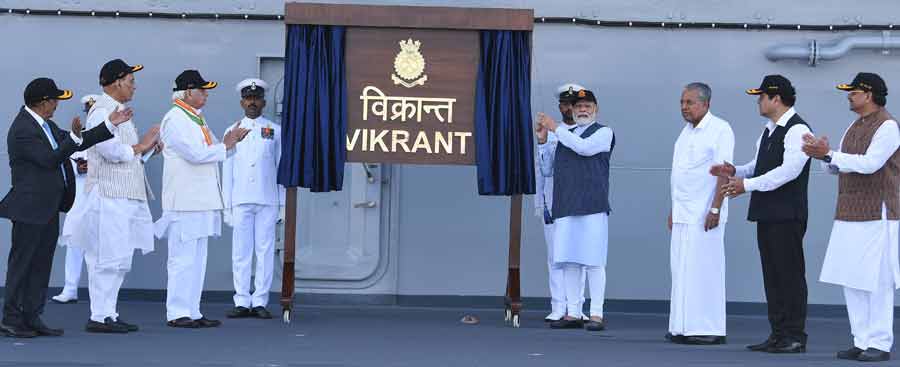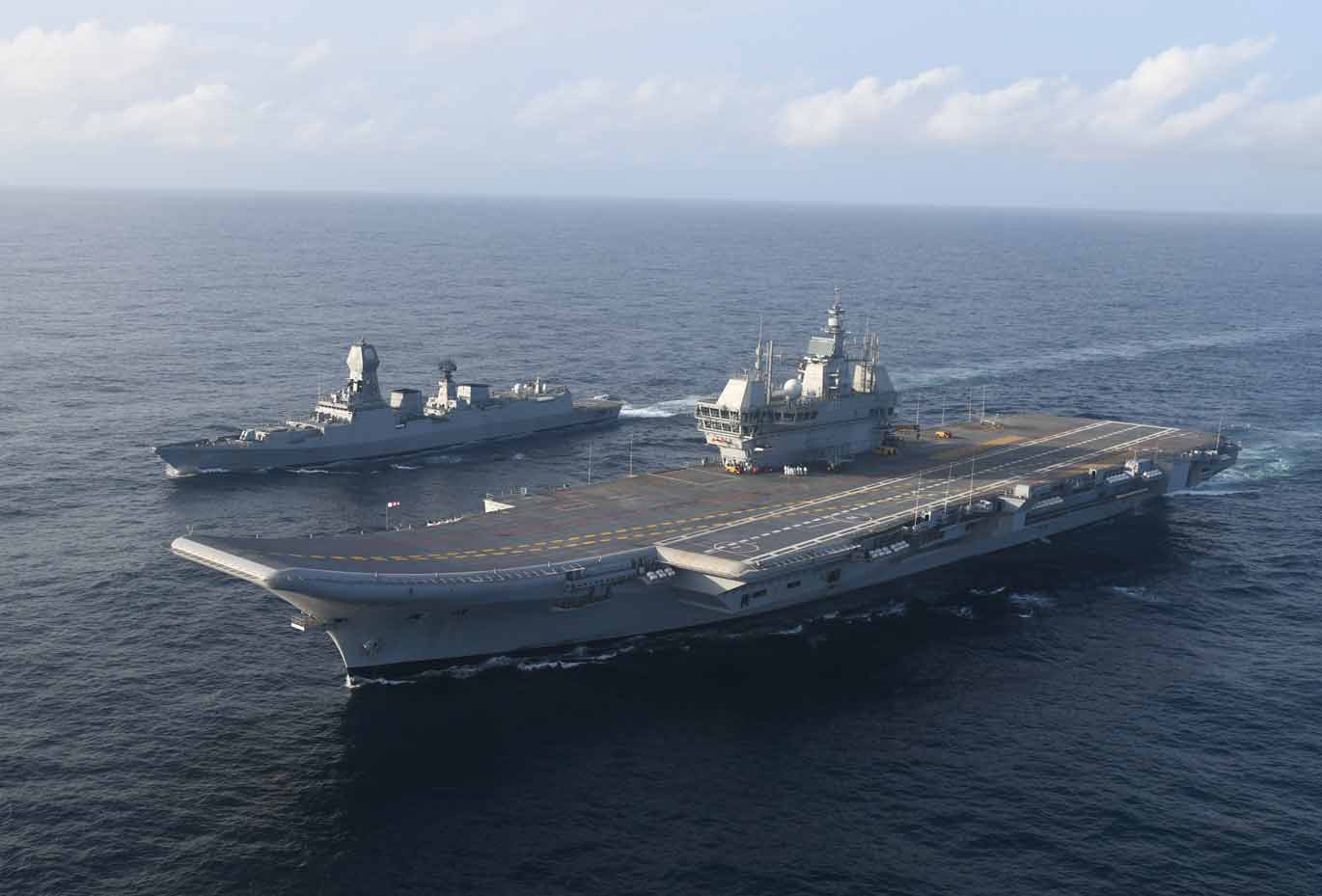India’s first home-made aircraft carrier: Can it meet the mounting threats in the Indo-Pacific?
Building an aircraft carrier yourself is one thing. The formation of Carrier Task Groups and aircraft is quite another, as India is discovering.
Sarosh Bana
25 September 2022

The commissioning on 2 September of India’s first Indigenous Aircraft Carrier (IAC), INS Vikrant, propelled the country into an elite league of nations – comprising the US, China, Russia, the UK, France, Spain and Italy - with the niche capability to design and build their own aircraft carriers.
But the 43,000 ton, 262.5m INS Vikrant, which is the largest and most complex warship ever designed and built in India by the Navy’s Directorate of Naval Design (DND), will set sail without its most vital component, an Aviation Facility Complex (AFC), which is meant to be supplied by Russia’s Nevskoe Design Bureau (NDB) by the end of next year.
The AFC will support a carrier air wing comprising MiG-29K fighter aircraft, Ka-31 airborne early warning helicopters, MH-60R multi-role helicopters, as well as the indigenous Dhruv Advanced Light Helicopters. But evaluating, testing and selecting the aircraft, and then training Indian naval aviators for them, will be a lengthy process.
Not only that, NDB, which is supplying the AFC, is among the 29 entities from Russia’s defence establishment that had sanctions imposed against them in April by the US Department of State following Russia’s invasion of Ukraine. India is, however, hopeful of following through on its deal with NDB in the same way it managed to secure a Countering America’s Adversaries Through Sanctions Act (CAATSA) waiver on its $5.3 billion order for five S-400 Triumf missile defence systems from Russia in 2018.
In July, the US House of Representatives legislated on an India-specific waiver under CAATSA by 330 to 99 votes, although it sanctioned Turkey, a NATO member, under CAATSA for the purchase of the same Russian missile defence systems.
India is the world’s biggest buyer of Russian arms, a legacy which stems from the Cold-War period. In the decade between 2011 to 2021, Russia made US$22.8 billion worth of arms transfers to India, which was 42% higher than the previous decade, according to the Observer Research Foundation. Given its heavy reliance on Russia for major weapon and defence systems, India has not joined the West in decrying Russia’s invasion of Ukraine.
But given Russia’s increasing isolation and the challenges the Russian military industrial complex faces in sourcing components from foreign suppliers for the weapons systems they manufacture, India is looking to meet more of its defence needs domestically, as well as diversifying its supplier base, according to Reuters.

IAC1 Vikrant with INS Kolkata (D63) during sea trials (Photo: Ministry of Defence, GODL-India <https://data.gov.in/sites/default/files/Gazette_Notification_OGDL.pdf>, via Wikimedia Commons)
More indigenous defence production for India
INS Vikrant, contains as much as 76% indigenous content, including the specialty steel used in the construction, key weapons and sensors, as well as the 2,500km of electrical cables that run through it.
Indian Navy Vice Chief, Vice Admiral S.N. Ghormade, also told reporters recently that while the carrier is designed to operate the Russian-made MiG-29K multi-role fighter, India will ultimately deploy the indigenous Twin-Engine Deck-Based Fighter it is working on with the Defence Research and Development Organisation. “For the interim, we are looking at the Rafale and F/A-18 aircraft, and trials have been carried out,” he said.
India’s 2016 Maritime Security Strategy, proposes a force structure based on the development of three Carrier Battle Groups (CBGs), each centred on an aircraft carrier with multi-mission escort and support ships with integral anti-air, anti-surface and anti-submarine warfare capabilities.
This entails the development of an operational capability of two Carrier Task Forces (CTFs), each comprising one or more CBGs and other specialist forces, to meet the growing requirements of protecting India’s maritime interests. However, these battle groups will only take formation sometime in 2024.
With 130 ships and submarines, and 39 more vessels under construction, the Indian Navy is considered the seventh most powerful in the world. But it is up against a growing maritime threat from China, whose military modernisation has become the top focus of even US defence planning and budgeting.
China has two operational carriers at present — the Soviet-designed Kuznetsov-class carrier Liaoning, which it bought back in 1998 and commissioned in 2012, and the Shandong, which is based on the Liaoning and entered service in 2019. Its third carrier, the 80,000-ton Fujian, is being fitted out, and a fourth aircraft carrier is likely to be a Carrier, Aircraft, Nuclear.
It has plans to build 10 aircraft carriers by 2049. However, only two carriers are envisaged for present by India, with INS Vikrant joining the fleet alongside the Navy’s 44,750-tonne INS Vikramaditya (ex-Russian Admiral Gorshkov), which entered service in 2013.
The Indian Ministry of Defence declined approval for a proposed 65,000-ton IAC-2, with Catapult Assisted Take-Off capability, as its $10 billion estimated price tag was deemed too exorbitant. However, the Parliamentary Standing Committee on Defence, made a case for a third carrier last December when it deemed it an “unavoidable requirement to meet any eventualities”, considering the “long coastline and hostile adversaries on both sides of the Indian peninsula.”
INS Vikrant in a nutshell:

Size: 262.5m
Beam: 62m
Height: 59m, including five superstructures
Maximum designed speed: 28kts (52kmph), cruising speed of 18kts (33.3kmph)
Endurance: 7,500nm (13,890km).
Decks: 14 decks, including five in the superstructures
Crew: 1,700